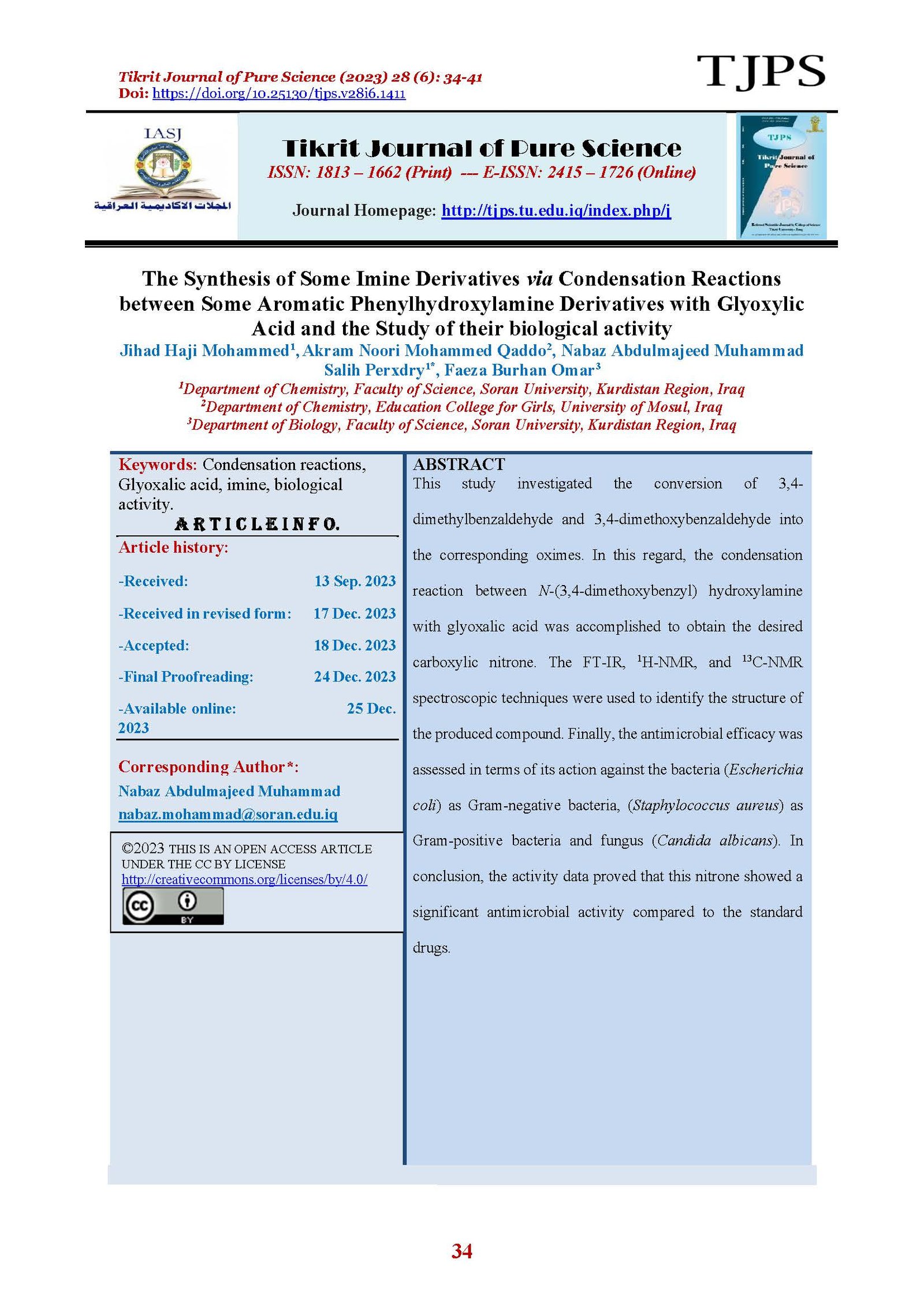The Synthesis of Some Imine Derivatives via Condensation Reactions between Some Aromatic Phenylhydroxylamine Derivatives with Glyoxylic Acid and the Study of their biological activity
Main Article Content
Abstract
This study investigated the condensation reactions between N-(3,4-dimethoxybenzyl)hydroxylamine and N-(4-methylbenzyl)hydroxylamine with glyoxalic acid. The objective was to obtain imine derivatives as the desired target products. FT-IR, 1H-NMR, and 13C-NMR spectroscopic techniques were used to identify the structures of the produced compounds. Different conditions were considered for these reactions and only N-(3,4-dimethoxybenzyl)hydroxylamine could be converted to the desired nitrone. Finally, the antimicrobial efficacy was assessed in terms of its action against the bacteria Escherichia coli (E.coli) as Gram-negative bacteria, Staphylococcus aureus (S.aureus) as Gram-positive bacteria and fungus (Candida albicans). The activity data proved that this nitrone showed significant antimicrobial activity compared to standard drugs.
Article Details

This work is licensed under a Creative Commons Attribution 4.0 International License.
Tikrit Journal of Pure Science is licensed under the Creative Commons Attribution 4.0 International License, which allows users to copy, create extracts, abstracts, and new works from the article, alter and revise the article, and make commercial use of the article (including reuse and/or resale of the article by commercial entities), provided the user gives appropriate credit (with a link to the formal publication through the relevant DOI), provides a link to the license, indicates if changes were made, and the licensor is not represented as endorsing the use made of the work. The authors hold the copyright for their published work on the Tikrit J. Pure Sci. website, while Tikrit J. Pure Sci. is responsible for appreciate citation of their work, which is released under CC-BY-4.0, enabling the unrestricted use, distribution, and reproduction of an article in any medium, provided that the original work is properly cited.
References
[1] H. Feuer, Nitrile Oxide, Nitrones & Nitronates in Organic Synthesis: Novel Strategies in Synthesis, Second Edi. New Jersey: JOHN WILEY & SONS, INC, 2008.
[2] A. N. M. Qaddo and A. A. Abed, ‘Heterocyclic Synthesis of Some New Isoxazolidine Derivatives via 1,3-Dipolar Cycloaddition of Nitrones to Styrene’, Iraqi J. Sci., vol. 63, no. 10, pp. 4175–4184, 2022 [Online]. Available: 10.24996/ijs.2022.63.10.4.
[3] J. H. M. Nabaz Abdulmajeed Mohammad Salih, ‘Synthesis and Characterization of Some New Nitrones Derivatives and Screening Their Biological Activities’, Sci. J. Univ. Zakho, vol. 11, no. 2, pp. 160–169, 2023 [Online]. Available: 10.1080/00945717908069779.
[4] S. I. Murahashi and Y. Imada, ‘Synthesis and Transformations of Nitrones for Organic Synthesis’, Chem. Rev., vol. 119, no. 7, pp. 4684–4716, 2019 [Online]. Available: 10.1021/acs.chemrev.8b00476.
[5] S. Z. and A. Z. Cherifa Mahieddine, Mohamed Salah Boukhechem, ‘Synthesis and Microbiological Activities of Novel Acyclic Nitrones’, Asian J. Chem., vol. 28, no. 5, pp. 1027–1030, 2016.
[6] L. L. Anderson, ‘Diverse Applications of Nitrones for the Synthesis of Heterocyclic Compounds’, Asian J. Org. Chem., vol. 5, no. 1, pp. 9–30, 2016 [Online]. Available: 10.1002/ajoc.201500211.
[7] J. Y. Pfeiffer and A. M. Beauchemin, ‘Simple reaction conditions for the formation of ketonitrones from ketones and hydroxylamines’, J. Org. Chem., vol. 74, no. 21, pp. 8381–8383, 2009.
[8] H. H. Salman et al., ‘Antimicrobial evaluation of some new nitrone compounds derived from glyoxal’, Int. J. Green Pharm., vol. 13, no. 3, pp. 275–280, 2019.
[9] H. I. Petkes et al., ‘Synthesis and antibacterial properties of new phenothiazinyl- and phenyl-nitrones’, Comptes Rendus Chim., vol. 17, no. 10, pp. 1050–1056, 2014.
[10] A. A. A.-F. Nesreen N.Majeed , Abbas.F.Abbas, ‘Synthesis and characterization of some new Nitrones derived from phthalocyanine compounds’, Tikrit J. Pure Sci., vol. 17, no. 4, pp. 129–137, 2012 [Online]. Available: 10.1088/1757-899X/557/1/012061.
[11] J. A. Stanko, ‘The Design and Synthesis of Novel Chiral Z-Nitrones with Applications towards the Syntheses of Enantiomerically Pure 4-Hydroxy Amino Acids’, Duke University, 2009.
[12] and J. T. Wolfgang Kliegel, Jörg Metge, Steven J. Rettig, ‘Synthesis of C-aryl-N-(2-hydroxyphenylmethyl)-nitrones and their reaction with diphenylborinic or carboxylic acid derivatives. Crystal and molecular structures of a free nitrone ligand and its diphenyl–boron chelate’, Can. J. Chem., no. 1, pp. 1–14, 2004.
[13] A. Lino and O. Deogracious, ‘The in-vitro antibacterial activity of Annona senegalensis, Securidacca longipendiculata and Steganotaenia araliacea - Ugandan medicinal plants’, Afr. Health Sci., vol. 6, no. 1, pp. 31–35, 2006.
[14] S. K. A. Y. S. Y. Kimuka, ‘Recent Advances in Streptococci and Strep- tococcal Diseases’, J.Basic Microbiol., vol. 26, no. 4, p. 240, 1986.
[15] H. H. Salman and N. N. Majeed, ‘Synthesis, Characterization and Study of Biological Activity of Some New Nitrone and Isoxazolidine compounds’, J. Basrah Res., vol. 39, no. 2, pp. 99–111, 2013.
